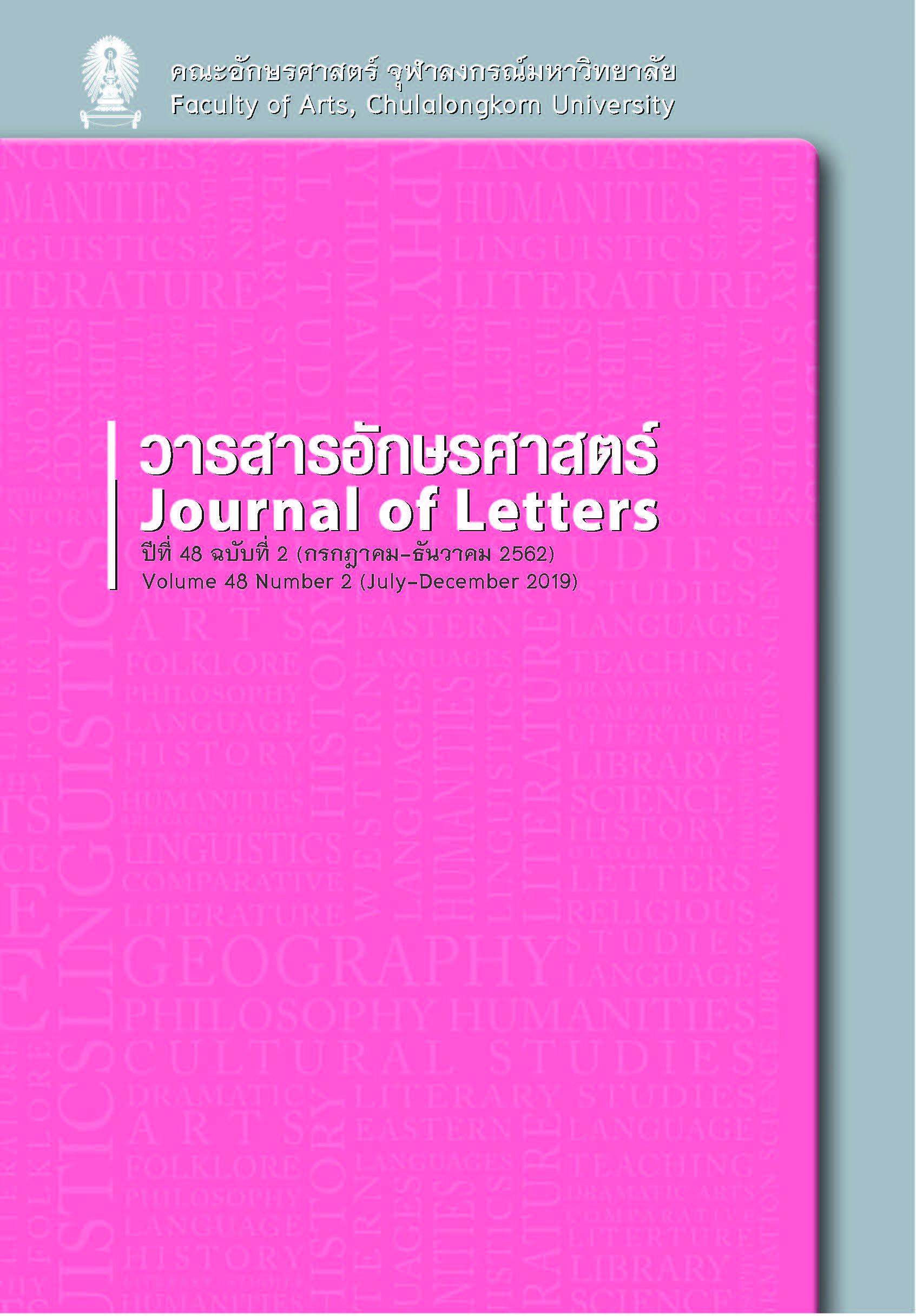The Negative Form ma:j2 as a Pragmatic Marker in Casual Conversations in Nakhon Si Thammarat Thai
Keywords:
negative form ma:j2, negation in Nakhon Si Thammarat Thai, Southern Thai Dialect, pragmatic marker, pragmaticsAbstract
When observing speakers of Nakhon Si Thammarat Thai talking in their daily life, it is found that the negative form ma:j2 can be used beyond negation. For example, they use ma:j2 to correct information, confirm what has been said, and show that they agree with other interlocutors. However, most previous studies of Southern Thai dialects have only viewed ma:j2 as a negative form syntactically and semantically, but not pragmatically. This article, therefore, aims to study the pragmatic functions of the negative form ma:j2 in casual conversations in Nakhon Si Thammarat Thai. Data were collected from 36 conversations between two or more female and male interlocutors of different ages, occupations, education levels and social status. Analysis shows that speakers use ma:j2 as a pragmatic marker to interact with other interlocutors on two levels. At the textual level, ma:j2 has two functions: correcting what has been said, and interrupting. At the interactional level, ma:j2 has six different functions: providing more information, clearing up another interlocutor’s misunderstanding, showing agreement, confirming, making excuses, and expressing that the topic mentioned is not important.
References
Kritsadawan Hongladarom, & Theeranuch Chokesuwanich กฤษดาวรรณ หงส์ลดารมภ์ และธีรนุช โชคสุวณิช. 2008. Watchanapatibatsat วัจนปฏิบัติศาสตร์ [Pragmatics]. Bangkok: Research and Publication Division, Faculty of Arts, Chulalongkorn University.
Rujira Bumrungkarn รุจิรา บำรุงกาญจน์. 2016. “Khunnasombat thang Wagayasamphan Utthasat lae Watchanapatibat khong Rup Patiset Mai lae Plao nai Phasa Thai” คุณสมบัติทางวากยสัมพันธ์ อรรถศาสตร์ และวัจนปฏิบัติของรูปปฏิเสธ ไม่ และ เปล่า ในภาษาไทย [Syntactic, Semantic, and Pragmatic Properties of Negative Forms /mâj/ and /plàaw/ in Thai]. Doctoral Thesis, Chulalongkorn University.
Rujira Suwannoy รุจิรา สุวรรณน้อย. 1998. “Datchani-paritchet nai Bot Sonthana Baep Kan-eng nai Phasa Thai Nakhon Si Thammarat” ดัชนีปริจเฉทในบทสนทนาแบบกันเองในภาษาไทยนครศรีธรรมราช [Discourse Markers in Casual Conversations in Nakhon Si Thammarat Thai]. Master Thesis, Chulalongkorn University.
The Royal Institute ราชบัณฑิตยสถาน. 2010. Potchananukrom Sap Phasasat (Phasasat Prayuk) พจนานุกรมศัพท์ภาษาศาสตร์ (ภาษาศาสตร์ประยุกต์) [Dictionary of Linguistics (Applied Linguistics)]. Bangkok: The Royal Institute.
Wilaiwan Dumrak วิไลวรรณ ดำรักษ์. 1970. “Rabop Nuay Siang nai Phasa Thai Thin Nakhon Si Thammarat” ระบบหน่วยเสียงในภาษาไทยถิ่นนครศรีธรรมราช [The Phonemic System of the Nakhon Si Thammarat Thai]. Master Thesis, Chulalongkorn University.
Aijmer, K., & Simon-Vandenbergen, A.-M. (Eds.). 2006. Pragmatic Markers in Contrast. Amsterdam: Elsevier.
Andersen, G., & Fretheim, T. (Eds.). 2000. Pragmatic Markers and Propositional Attitude. Amsterdam: John Benjamins.
Austin, John L. 1962. How to Do Things with Words. London: Oxford University Press.
Bernini, G., & Ramat, P. 1996. Negative Sentences in the Languages of Europe. Berlin: Mouton de Gruyter.
Bhamoraput, Amara. 1972. “Final Particles in Thai.” Master Thesis, Brown University.
Brinton, Laurel J. 1996. Pragmatic Markers in English: Grammaticalization and Discourse Functions. Berlin: Mouton de Gruyter.
Brown, P., & Levinson, S. C. 1987. Politeness: Some Universals in Language Usage. Cambridge: Cambridge University Press.
Cooke, Joseph R. 1989. Thai Sentence Particles: Forms, Meanings, and Formal-Semantic Variations. Papers in Southeast Asian Linguistics No.12, Thai Sentence Particles and Other Topics 12: 1-90.
Grice, Paul. 1975. Logic and Conversation. In Syntax and Semantics 3: Speech Acts, Peter Cole, & Jerry Morgan, eds., 41-58. New York: Academic Press.
Halliday, M. A. K. 2004. An Introduction to Functional Grammar (3rd ed.). London: Hodder Education.
Horn, Laurence R. (Ed.). 2010. The Expression of Negation. New York: de Gruyter Mouton.
Leech, Geoffrey. 1983. Principles of Pragmatics. London: Longman.
Lee-Goldman, Russell. 2011. No as a Discourse Marker. Journal of Pragmatics 43: 2627-2649.
Noss, Richard. 1964. “Thai Reference Grammar.” Doctoral Dissertation, Yale University.
Saville-Troike, Muriel. 2003. The Ethnography of Communication: An Introduction (3rd ed.). New York: Blackwell.
Searle, John. 1970. Speech Acts: An Essay in the Philosophy of Language. Cambridge: Cambridge University Press.
Tomlin, R. S., Forrest, L., Pu, M. M., & Kim, M. H. 2011. Discourse Semantics. In Discourse Studies: A Multidisciplinary Introduction (2nd ed.), ed. Teun A. Van Dijk, 37-63. London: Sage.
Wang, Y.-F., Tsai, P.-H., & Ling, M.-Y. 2007. From Informational to Emotive Use: Meiyou (‘no’) as a Discourse Marker in Taiwan Mandarin Conversation. Discourse Studies 9(5): 645-669.
Wilson, D., & Sperber, D. 2006. Relevance Theory. In The Handbook of Pragmatics, Laurence R. Horn, & Gregory Ward, eds., 607-632. Hong Kong: Blackwell.
Downloads
Published
How to Cite
Issue
Section
License
Copyright and plagiarism
Authors are responsible for obtaining permission to use copyrighted materials from copyright owners. Authors are responsible for observing requisite copyright law when quoting or reproducing copyrighted materials. Quotations and reproductions of content from other published sources must be accompanied by a reference and all sources should be clearly listed in the references section. Quotations and reproductions of content from external sources without due attribution could be considered a severe infringement of academic conduct and may constitute a legal offence under the Copyright Act of B.E. 2537. Any legal ramifications arising from the infringement of copyright regulations would be the sole responsibility of the author(s).



